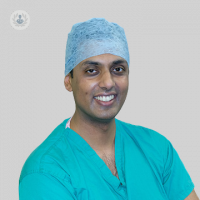Crossed-eyes: can they be fixed? Strabismus explained
Written by:Children will often cross their eyes to have fun and be silly, but for some children (and even adults), having crossed eyes can be something they can’t help or control. The medical term for this is known as strabismus and it is described as when both eyes are not fully aligned and working together. Mr Imran Jawaid, a leading ophthalmologist, explains what it is, the different types, and the treatments available.

What is strabismus?
Strabismus is a misalignment of the eyes, where the eyes do not work together and do not look in the same direction. There are four main directions that the misaligned eye could be turning:
- inwards towards the nose (esotropia)
- outwards (exotropia)
- down (hypotropia)
- up (hypertropia)
People with strabismus are often referred to as being cross-eyed. Strabismus can be constant or intermittent.
What are the symptoms?
The severity of the misalignment between the eyes can vary. Some people have very large differences between the two eyes, where it is obvious to the onlooker that their eyes are not working together. This is referred to as large-angle deviation.
Because the eyes are so far apart, the brain is presented with two completely separate images (one from each eye) and as a compensation mechanism, the brain often ignores the image from the misaligned eye to avoid experiencing double vision. These patients do not suffer from any noticeable symptoms because they suppress one eye, however, they will lack depth perception as both eyes are required for this. There is also a risk that the patient will develop amblyopia (lazy eye) in the misaligned/suppressed eye when it is ignored by the brain.
For those to have smaller amounts of strabismus, the brain will attempt to fuse the two images from each eye together. This can cause symptoms such as eye strain, fatigue, headaches and difficulty concentrating on visual tasks. There is also a risk of a lazy eye developing in the misaligned eye.

Who is likely to develop it?
Strabismus largely develops from infancy and childhood due to eye muscle problems, developmental issues or injury.
There are certain factors which can increase the risk of developing strabismus. For example, if there is a family history of strabismus, children are more likely to develop the condition [1]. Those with a high level of long-sightedness are also at a higher risk of developing strabismus due to over-focusing [2].
Strabismus is especially common in children with certain medical conditions including cerebral palsy, Down syndrome [3], hydrocephalus, brain tumours and prematurity.
In adults, strabismus can be caused by certain medical conditions including Grave’s disease, neurological disorders, stroke, and brain injury.
Do crossed eyes affect vision?
Strabismus can cause double vision. This is because the two eyes are facing different directions, therefore producing two separate images. When these images are too far apart from each other, the patient can experience diplopia or double vision. This causes visual confusion for the patient.
It is too difficult to process and function with double vision, therefore, as a method of compensation, the brain will adapt and learn to ignore the misaligned image. This is called suppression. It can be thought of as a coping mechanism. The issue with suppression of one eye is that if that eye is not being used, and is constantly ignored by the brain, it can become ‘lazy’ (amblyopic) and the vision can deteriorate significantly in that eye [4].
How is it treated and is it reversible?
Treatment of strabismus varies depending on the cause of the condition, the severity and the vision of the patient. There are several treatments which can be used to straighten out the eyes, including:
- correction with glasses or contact lenses
- prismatic lenses in glasses
- eye exercises
- Botox
- Patching
- eye muscle surgery
A combination of treatments is often prescribed for patients on a case-by-case basis.
What’s the long-term outlook?
There is no overall outlook for strabismus. It is very much a case by case basis depending on the cause of the condition and the treatment options.
The brain is a very powerful tool and is equipped with compensation and adaptation mechanisms, allowing patients with strabismus to develop neural and visual cues in order to compensate for the fact that their eyes do not work together.
Strabismus patients will face a number of occupational restrictions (e.g. pilots, army, air force, etc.) because their condition does not allow them to join certain occupations due to predetermined visual criteria. In general, the condition does not tend to hinder functioning in modern adult life in any significant way. It does, however, have a significant impact on quality of life from a psychological point of view.
Patients growing up with strabismus report feelings of sadness and inferiority [5], therefore eye muscle surgery is a popular option.
References
[1] Aurell E, Norrsell K. A longitudinal study of children with a family history of strabismus: factors determining the incidence of strabismus. Br J Ophthalmol. 1990;74(10):589–594.
[2] Dana Robaei, Kathryn A. Rose, Annette Kifley, Michael Cosstick, Jenny M. Ip, Paul Mitchell,
Factors Associated with Childhood Strabismus: Findings from a Population-Based Study,
Ophthalmology . 2006 ;113,(7):1146-1153.
[3] Yurdakul NS1, Ugurlu S, Maden A. Strabismus in Down syndrome. J Pediatric Ophthalmoly Strabismus. 2006 Jan-Feb;43(1):27-30.
[4] Jingrong Li, Benjamin Thompson, Carly S. Y. Lam, Daming Deng, Lily Y. L. Chan, Goro Maehara, George C. Woo, Minbin Yu, Robert F. Hess; The Role of Suppression in Amblyopia. Invest. Ophthalmol. Vis. Sci. 2011;52(7):4169-4176. doi: 10.1167/iovs.11-7233.
[5] Ribeiro, Geraldo de Barros, Bach, Ana Gabriela Zum, Faria, Camila Maia, Anastásia, Suze, & Almeida, Henderson Celestino de. (2014). Quality of life of patients with strabismus. Arquivos Brasileiros de Oftalmologia, 77(2), 110-113.
If you have Strabismus and would like to speak to Mr Jawaid about your condition, do not hesitate to book an appointment through his Top Doctors profile today.


